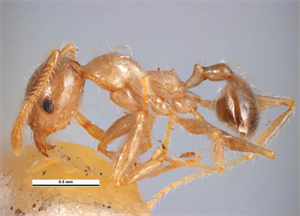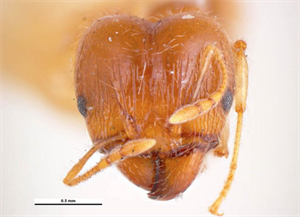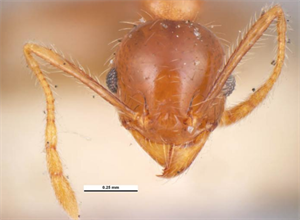Big-headed ant, African big-headed ant, coastal brown ant.
Pacific Pests, Pathogens and Weeds - Online edition
Pacific Pests, Pathogens & Weeds
Big-headed ant (361)
Pheidole megacephala
Asia, Africa, North, South, and Central America, the Caribbean, Europe, Oceania. it is recorded from Australia, Cook Islands, Fiji, French Polynesia, Guam, Kiribati, Marshall Islands, New Caledonia, New Zealand, Niue, Northern Mariana Islands, Palau, Papua New Guinea, Samoa, Solomon Islands, Tokelau, Tonga, Vanuatu, Wallis and Futuna Islands.
Nests of Pheidole megacephala are found under rotten logs, stones, tree bark and within leaf litter. More occasionally, nests occur in wall cavities and ceilings, and the ants forage in kitchens and bathrooms.
Pheidole megacephala is one of the world's most invasive ant species. Direct damage occurs when seeds are taken as food, affecting agriculture, and home invasions result in chewed electrical and telephone cables. Indirect damage results from the ants' association with aphids, mealybugs, scale insects and whiteflies. They feed on the honeydew from these pests and protect them from their natural enemies and, consequently, pest populations increase to damaging levels. Furthermore, the honeydew excreted by these insects is colonised by sooty moulds turning leave black and blocking photosynthesis.
Big-headed ants prefer disturbed habitats, agricultural and urban areas in tropical and subtropical countries, but they also invade rainforests. Once the colony is established, biodiversity of the area becomes depleted.
Queens mate once, within the colony, laying more than 200 eggs a months. After mating, the male dies. Workers are pale yellow to very dark brown. There are two types, 'major' and 'minor'. The major workers are soldiers about 3-4 mm long, with distinctly large heads (hence the common name) (Photos 1&2); the minor workers are 2 mm long, with heads of normal size (Photo 3). Minor workers stay mostly within the nest, caring for the brood (larvae and pupae) and the queen. A majority of workers are of this kind.
These ants often build tubes of soil over their foraging trails.
Apart from honeydew and seeds, the ants feed on insects, and their eggs, as well as small lizards and birds. They are general scavengers.
Spread occurs by 'budding', as workers, brood (larvae and pupae) and fertile queens, move from the existing colony to establish new nests nearby in a variety of places: under wood, crevices of bark, leaf litter, paving stones, and even within the walls of buildings. Dispersal over long distances, beyond the borders of a colony, is associated with traded goods as long as fertile queens are present together with minor workers and pupae. The minor workers are essential to feed the newly-hatched larvae.
Pheidole megacephala is known as a 'tramp' ant. These are ants that have become widely distributed globally associated with increased trade and commerce. It is one of the five worst ants threatening the Pacific according to PIAT (Pacific Invasive Ant Toolkit), together with the little fire ant, the red imported fire ant, the yellow crazy ant, and the Argentine ant (http://www.piat.org.nz/problem-ants/worst-5-identification). It is also among 100 of the World's Worst Invasive Alien Species, published by The Invasive Species Specialist Group (ISSG), a specialist group of the Species Survival Commission of the World Conservation Union. (http://www.issg.org/pdf/publications/worst_100/english_100_worst.pdf).
As the ISSG states: "It is a serious threat to biodiversity through the displacement of native invertebrate fauna and is a pest of agriculture as it harvests seeds and harbours phytophagous insects that reduce crop productivity".
Protection of sap-sucking insects from their natural enemies resulting in pest outbreaks is not the only indirect consequence of Pheidole infestations. Plants may also suffer from toxins and/or viruses carried by these pests. For example, see Fact Sheet no. 282 and the association of the pink mealybug, Dysmicoccus brevipes, with pineapple wilt disease. There is also evidence that this ant transfers spores of the oomycete, Phytophthora palmivora, within soil debris used to build tents over mealybug colonies on cocoa pods, resulting in outbreaks of black pod disease (see Fact Sheet no. 06).
Look for pale yellow to brown ants, and for the major workers with their large heads; separation to species needs the assistance of a taxonomist familiar with the megacephala group.
The PIAkey provides charts with three similar Pheidole species - magacephala, oceanica and fervens - side-by-side for comparisons of important taxonomic features. (http://idtools.org/id/ants/pia/Fact_Sheets/Pheidole_megacephala.html).
The app: Antkey Mobile: an identification key for introduced ants. USDA. LUCID, is useful for preliminary examinations, as is the online version: (http://idtools.org/id/ants/pia/PIAkey_v2.html).
The Pacific Invasive Ants Taxonomy Workshop manual has a key to the Pacific species and is well illustrated (http://www.issg.org/cii/Electronic%20references/pii/project_docs/papp/pacific_ants_taxonomy_workshop_2009.pdf).
QUARANTINE
Countries that are still free from, but vulnerable to the big-headed ant, need to: (i) define the risk; (ii) have preventive measures in place against an introduction; (iii) have quarantine protocols enacted in case a breach occurs; and (iv) be able to effect a rapid response against this ant and others. It is important to have rapid response procedures in place in case eradication is a possibility. In addition, it is necessary to have biosecurity regulations to prevent movement of the ant within the country, especially in Pacific island countries where most are island groups or archipelagos. Finally, monitoring is required on the islands still free from infestation.
A Pacific Ant Prevention Plan has been written on behalf of the IUCN/SSC Invasive Species Specialist Group and presented to the Pacific Plant Protection Organisation and Regional Technical Meeting for Plant Protection (2004). Pheidole megacephala is one of the 11 species covered. (http://issg.org/database/species/reference_files/PAPP.pdf). The Plan focuses on ways to prevent the introduction, establishment and spread of this ant.
Guidelines to assist Pacific island countries and territories in planning effective management of invasive species have also been prepared by the Pacific Community and the Secretariat of the Pacific Regional Environment Programme. (http://www.piat.org.nz/uploads/PIAT_content/pdfs/SPREP%20guidelines%20for%20invasive%20species%20management%20in%20the%20Pacific.pdf).
The IUCN/SSC Invasive Species Specialist Group website should be consulted for details on all aspects of eradication and management of invasive ants (http://www.issg.org/).
CULTURAL CONTROL
Hot water at 47°C (and above) kills ants. Hot water up to 49°C will not damage plants. A more extreme method is to use fire to destroy the nests and to create conditions that favour native ant species.
CHEMICAL CONTROL
In three types of chemicals are used against ants: (i) stomach poisons. e.g., Maxforce® (fipronil), Amdro® (hydramethylnon), and borax; (ii) insect growth regulators (e.g., Engage® (methoprene), and Distance® (pyriproxyfen); and (iii) poisons that work on the nervous system, that is, neurotoxins, e.g., bifenthrin, fipronil, and imidacloprid. Stomach poisons kill all queens, intercastes and workers; insect growth regulators stop the queens from laying eggs, whereas neurotoxins disrupt insects' central nervous system. It is likely that future products will combine toxins that cause rapid death and insect growth regulators, e.g., Extinguish Plus® (hydramethylnon and methoprene).
A note of caution: Although it is possible to combine a lure (such as peanut butter, fish, sugar, etc.) with a pesticide as an ant bait, it is not recommended because of the danger in leaving concentrated pesticides unattended in the environment, including dwellings.
The eradication of the big-headed ant in Kakadu National Park, Australia [using hydramethylnon (Amdro®) and boric acid], is a case study in the Pacific Invasive Ant Toolkit: (http://www.piat.org.nz/getting-rid-of-ants/management-case-studies/african-big-headed-ant-management-case-studies). See also treatment options in the Pacific Invasive Ant Toolkit under (http://piat.org.nz/getting-rid-of-ants).
____________________
When using a pesticide, always wear protective clothing and follow the instructions on the product label, such as dosage, timing of application, and pre-harvest interval. Recommendations will vary with the crop and system of cultivation. Expert advice on the most appropriate pesticides to use should always be sought from local agricultural authorities.
AUTHOR Grahame Jackson
Information from CABI (2018) Pheidole megacephala (big-headed ant). Crop Protection Compendium. (https://www.cabi.org/cpc/datasheet/40133); and Pacific Invasive Ant Toolkit. (http://piat.org.nz/ant); and Pheidole megacephala. AntWiki. (http://www.antwiki.org/wiki/Pheidole_megacephala); and AntWeb. (https://www.antweb.org/description.do?rank=species&genus=pheidole&name=megacephala); and from Pheidole megacephala (2018) Global Invasive Species Database. (http://www.iucngisd.org/gisd/speciesname/Pheidole+megacephala). Photos 1-3 Simon Hinkley & Ken Walker (2006) Coastal brown-ant (Pheidole megacepahala). Museum of Victoria. PaDIL - (http://www.padil.gov.au).
Produced with support from the Australian Centre for International Agricultural Research under project HORT/2016/185: Responding to emerging pest and disease threats to horticulture in the Pacific islandsduction, implemented by the University of Queensland and the Secretariat of the Pacific Community.






